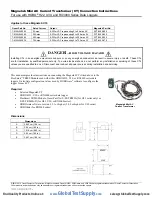
Maintenance
OPM223/253
72
7.2.2
Cleaning the pH/ORP sensors
Please clean
contamination on the glass electrodes
as follows:
• Oily and greasy films:
Clean with detergent (grease dissolvers, such as alcohol, acetone, poss. washing-up
liquids).
#
Warning!
When using the following cleaning agents, make sure to protect your hands, eyes and clothing!
• Lime and metal hydroxide layers:
Dissolve layers with diluted hydrochloric acid (3 %) and then rinse carefully with a lot of clear
water.
• Layers containing sulphide (from flue gas desulphurising or sewage treatment plants):
Use mixture of hydrochloric acid (3 %) and thiocarbamide (usual commercial) and then rinse
carefully with a lot of clear water.
• Layers containing proteins (e.g. food industry):
Use mixture of hydrochloric acid (0.5 %) and pepsin (usual commercial) and then rinse
carefully with a lot of clear water.
Clogged diaphragms
can be cleaned mechanically (does not apply to Teflon diaphragms and
open ring junction electrodes):
• Use a small warding file.
• Only file in one direction.
Air bubbles in the electrode:
• Air bubbles can indicate incorrect mounting. For this reason check the orientation.
• The range 15 to 165 to the horizontal is allowed.
• Not permitted: horizontal installation or installation with the plug-in head pointing downwards.
C07-OPM2x3xx-05-06-00-xx-006.eps
Fig. 39: Permitted angle of installation for glass electrodes
ORP electrodes:
Carefully clean the metal pins or surfaces mechanically.
!
Note!
After mechanical cleaning, the ORP sensor can require several hours conditioning time. For
this reason, check the calibration after a day.
7.2.3
Liquid KCl supply
• The KCl must be free of bubbles. In the case of an unpressurised version, check whether the
cotton thread is present in the hose.
• In the case of counterpressure, check whether the pressure in the KCl tank is min. 0.8 bar
(11.6 psi) above the medium pressure.
• The KCl consumption should be low but noticeable. Approx. 1 ... 10 ml/day is typical.
• The opening for sensors with a KCl top-up opening at the glass shaft must be clear.
7.2.4
Assembly
Please refer to the corresponding assembly Operating Instructions for information on
maintaining and trouble-shooting the assembly. Here you can find a description for assembling
and disassembling, sensor replacement, seal replacement, stability as well as information on
spare parts and accessories.
> 15°
> 15°
Содержание OPM223
Страница 2: ......
Страница 95: ...OPM223 253 Technical data 95...
Страница 100: ...Appendix OPM223 253 100...
Страница 103: ...OPM223 253 103...
Страница 104: ...BA194e 00 07 09 71106576 Printed in Germany FM SGML 6 0 DT 71106576...
















































